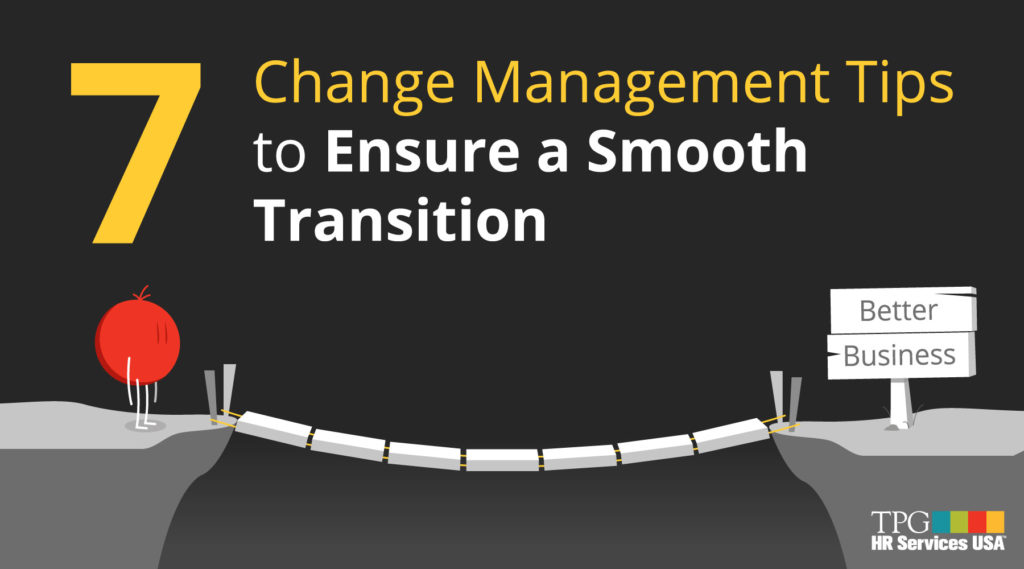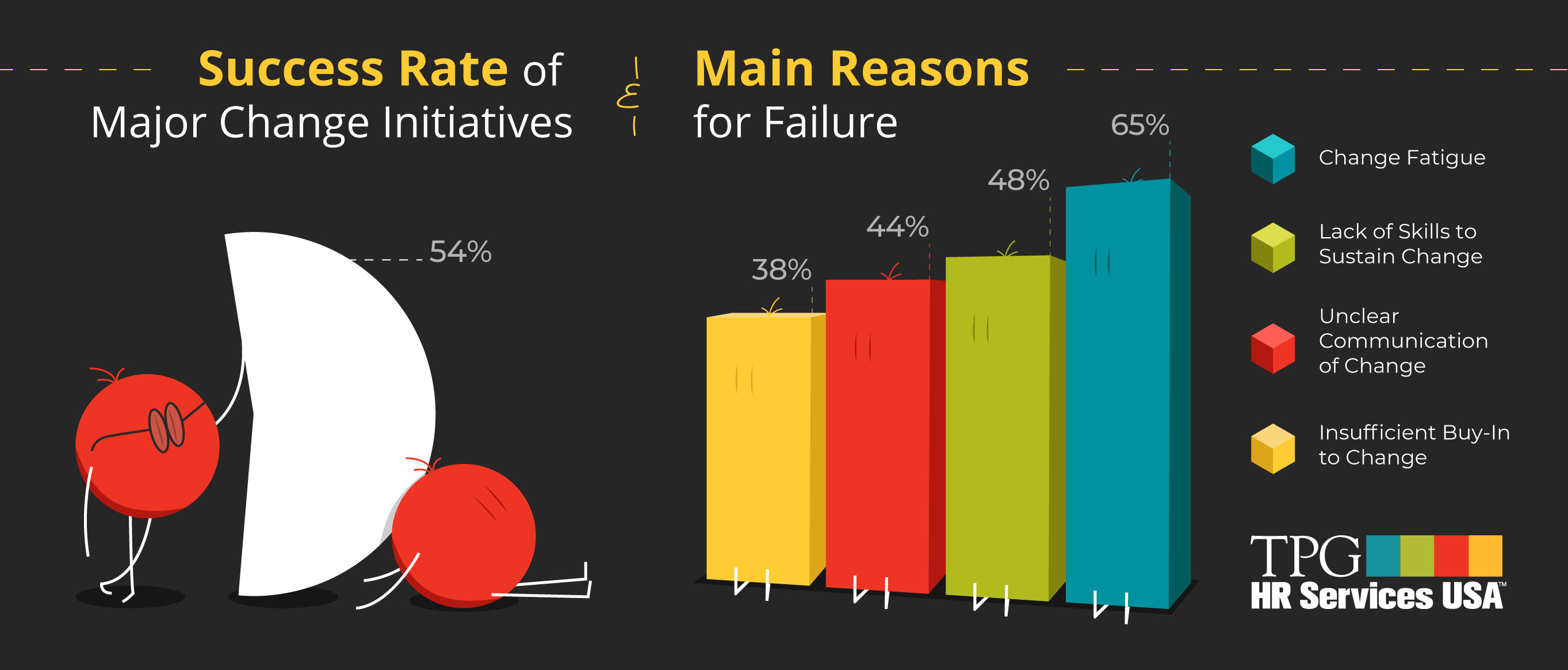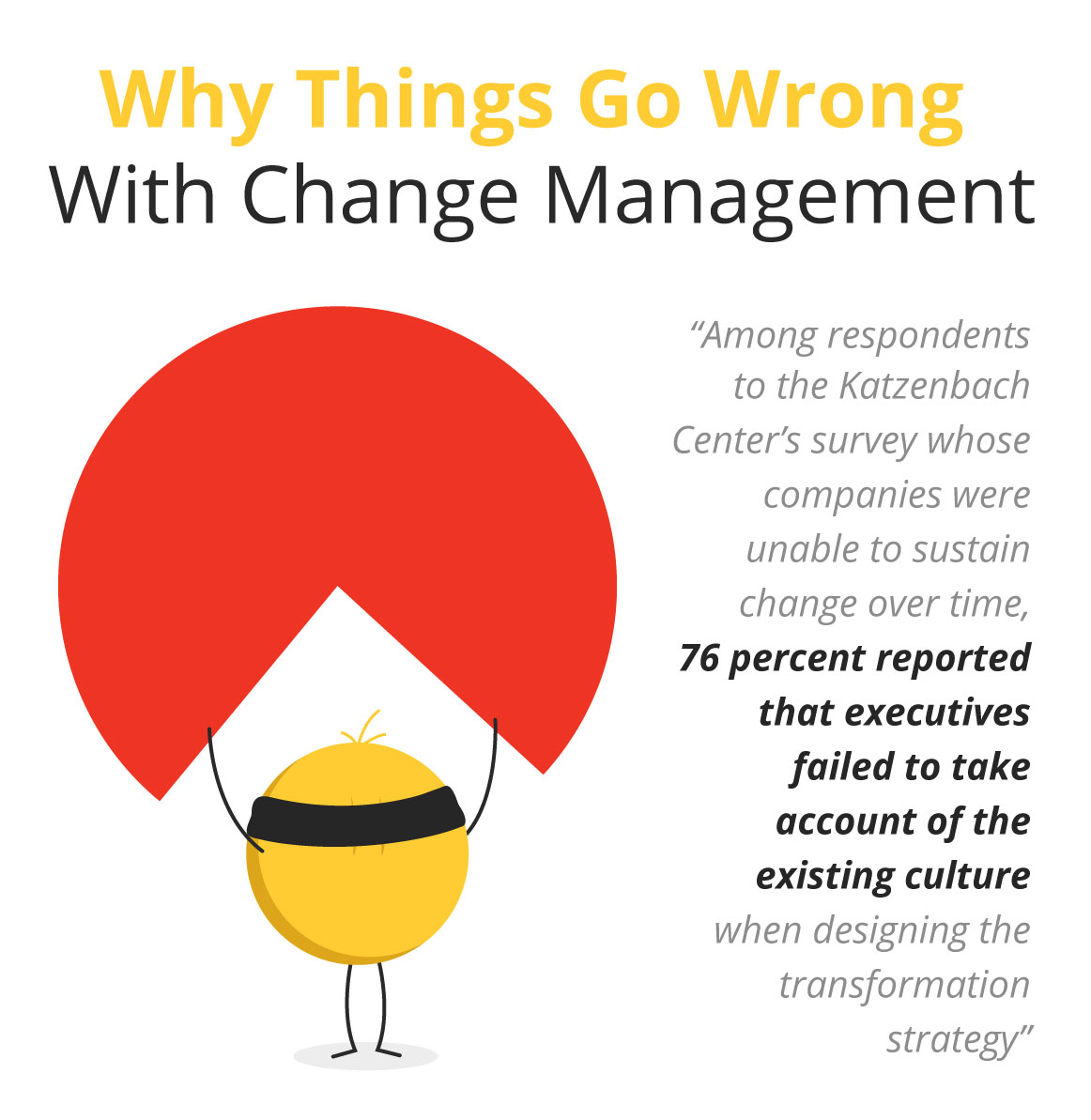
7 Change Management Tips to Ensure a Smooth Transition

Ms. Pomerantz is the CEO of TPG HR Services USA and has over 35 years of Human Resources practices experience. She holds a Master’s in Human Resource Management (MHRM) and is a certified Senior Professional in Human Resources (SPHR) and SHRM Senior Certified Professional (SHRM-SCP). Mary also serves as CEO of Mary Pomerantz Advertising, one of the largest recruitment advertising agencies in the country. Earlier in her career, she was president of the 17th largest staffing firm in the country.

Since the mid-2000s, new markets, labor pools, and technology have forced companies to dramatically change their business models in order to adapt and thrive, making change management a critical component to any company’s success. However, according to a 2013 Katzenbach Center survey of global senior executives, the success rate of major change initiatives is only 54 percent. Based on this data, all companies could probably benefit from some helpful change management tips to improve the chances for a smooth transition during any major business transformation. The following seven tips are a great starting point for any company contemplating a dramatic change to its business operations.

1. Focus on the culture
When implementing change management, it is critical to focus on the workplace culture of the company involved. In the Katzenbach Center survey, 84 percent of respondents stated that “the organization’s culture was critical to the success of change management” both in terms of overcoming cultural resistance to change in the workplace and tapping into cultural resources that might help make the change process more successful. [1]

To be effective, change managers must make the most of the company’s existing culture by tapping into the way the existing workforce already thinks, feels, and behaves. They need to identify elements of the workplace culture that align with the change they want to bring about and bring those elements forward.
2. Start at the Top, but Involve Every Layer
Successful change management starts at the top, with a committed and well-aligned group of executives who agree with the case for the change and the specific strategy for executing it. Oftentimes this can best be accomplished by assembling upper-level executives for a conference or retreat where they can all form a common vision for how the process should move forward. This exercise can be a difficult one if different leaders in the organization come to the table with substantially different perspectives, but the time to iron out these differences is in the early stages so that leadership presents an organized front when they roll out the change management initiative to the rest of the workforce.
ORGANIZATIONS DO NOT CHANGE, PEOPLE DO.
“When your organization undertakes projects or initiatives to improve performance, seize opportunities or address key issues, they often require changes; changes to processes, job roles, organizational structures and types and uses of technology. However, it is actually the employees of your organization who have to ultimately change how they do their jobs. If these individuals are unsuccessful in their personal transitions, if they don’t embrace and learn a new way of working, the initiative will fail.“
[2] What is Change Management?
While it always makes sense to start change management at the top, every layer of the workforce should be involved as much as possible. Lower-level employees should be included early on to have real input on the aspects of the change that impact their area of responsibility. These people can often help to identify possible stumbling blocks and technical or logistical issues that may crop up later, enabling you to avoid them entirely. Early input by every layer of the organization can also help the entire workforce feel more invested in the success of the final plan.
3. Make an Emotional as Well as Logical Argument for Change

To get your workforce to genuinely commit to the cause of change, you need to make more than just a logical argument for it; you need to make them connect with the cause on an emotional level as well. Successful change management strategies make employees feel that they are a part of something meaningful that is bigger than themselves. To accomplish this, you need to try and reach the hearts and minds of your employees. Sometimes, even small details can make all the difference in this process, such as addressing some perceived slights against employees within the new transformational order. But, to make this kind of emotional appeal, you need to really know and listen to your audience so that it doesn’t fall flat or sound like a “canned” statement from management.
4. Actions Speak Louder than Words
A revised organizational chart and lofty mission statements have only so much impact on your workforce when you are undergoing a change management project. It is much more impactful to have your senior leadership begin to model the new behaviors you are looking for than to simply mouth platitudes from on high. By identifying a few key behaviors from the start that leaders can demonstrate in action, your workforce is much more likely to “buy-in” to your change management message from the start. You should always keep in mind that most employees have already witnessed a failed, empty attempt at change in your company or another in their work lifetime; words will always ring hollow if they aren’t accompanied by real, concrete actions from the start.

5. Engage Employees, Particularly Informal Leaders
Although actions are critical, words also have their place in change management strategy. Powerful and sustained change requires constant communication, not only throughout the rollout but after the major elements of the plan are in place. And, the more kinds of communication employed, the more effective they are. Some of these communication techniques can include question and answer sessions, department-level meetings, online updates and discussion boards, and many more. Each new method of communicating with and listening to your employees increases the chances that your change management plan will truly take root among your employees, as they begin to feel like genuine stakeholders in the process.

Make sure to engage the informal leaders throughout your organization who make up a very important segment of your overall workforce. These individuals may not top many organizational charts but can be critical influencers among your staff. Informal leaders can be found at every level of an organization from well-liked lower-level managers to innovative technical staff to administrative personnel who have “seen everything” in their years at your company. The table below describes three distinct types of informal leaders that are identified in the article: 10 Principles of Leading Change Management. [1]
3 Types of Informal Leaders
Pride Builders
These informal leaders are great at motivating others and inspiring them to take pride in their work. People influenced by them feel good about working for the organization and have a desire to go above and beyond.Trusted Nodes
These informal leaders are go-to people. They are repositories of the organization’s culture. They are the ones approached by people who want to know what’s really happening in the organization—for example, when they’re trying to figure out if those leading a change initiative are actually going to follow through.Culture Ambassadors
These informal leaders know, as if by instinct, how to live the change the organization is making. They serve as both exemplars and communicators, spreading the word about why change is important.6. Tap Into Existing Structures to Support Change
To make a change management strategy really take root, you need to ensure that existing structures such as bonus calculations, compensation evaluations, and other forms of recognition all serve to reward individuals and teams that are implementing the new behaviors you are trying to encourage. Even if your initial message inspires numerous employees to support the change initiative, that energy will soon peter out if it is not followed up with concrete rewards. If you wouldn’t expect employees to perform their traditional duties without being rewarded, why should you expect them to embrace new and potentially unsettling changes without recognizing their achievements in a concrete fashion?
7. Continually Assess Results Throughout the Process

Every change management project needs to continually assess its progress throughout the life cycle of the process. Results must be measured against concrete, quantifiable goals that can help you determine when you have succeeded or when you need to readjust elements of your plan in response to components that have not measured up. Even change management training programs themselves are now being assessed with newly created quantitative measures such as those proposed in “A Conceptual Framework for Assessing Development Programmes for Change Agents.” [3] Without assessment and adaptation based on the results, the change initiative will inevitably fail on one or more measures. In addition, fact-driven assessments of even failed initiatives can yield important data that can make the next attempt much more likely to succeed.
Need Help with Your Next Change Management Initiative?
Change management is one area where outside assistance can be incredibly valuable. In fact, it is almost the perfect example of a business process that can gain tremendous value from having an independent, outside partner help you navigate the natural human tendency to resist change or not being able to “see the forest for the trees.” The experienced team at TPG HR Services can be that partner for your business the next time you need to dramatically transform your organization. Give us a call at 732-917-6000 to find out how we can help your company adapt to the ever-changing business climate.
